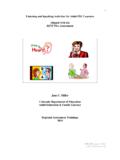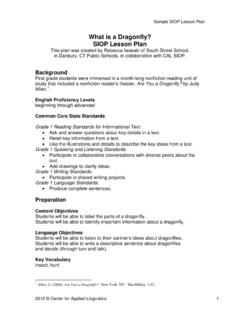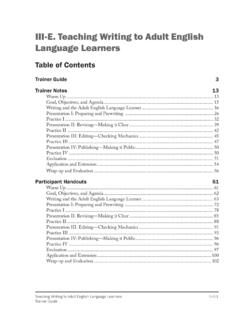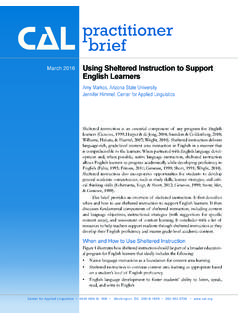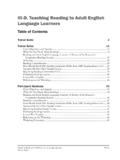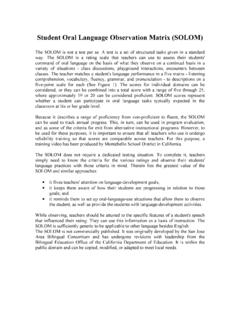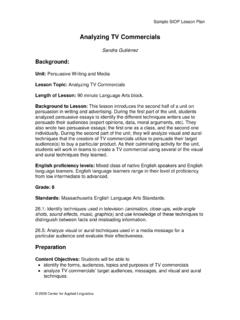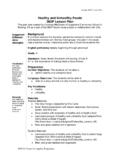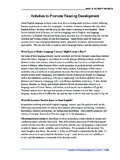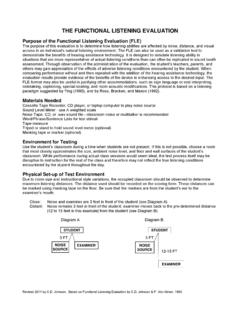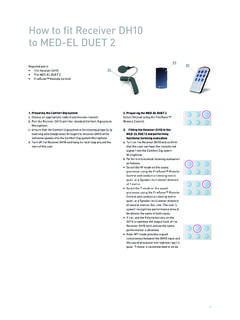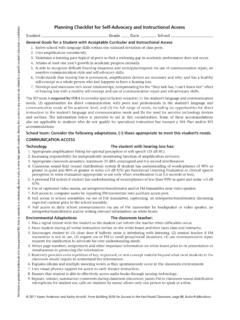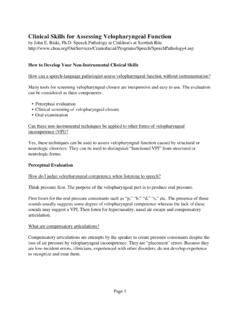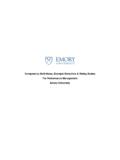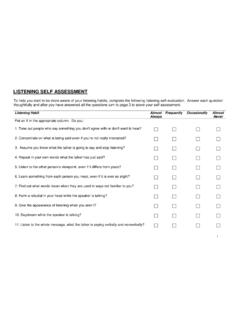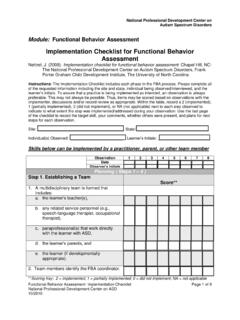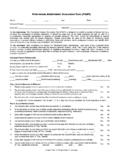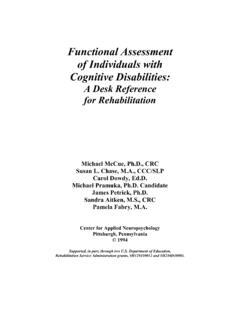Transcription of English Language Assessment Instruments for Adults ...
1 _____ PART IV: TOPICS IN ADULT ESL EDUCATION & FAMILY LITERACY English Language Assessment Instruments IV 31 English Language Assessment Instruments for Adults Learning English This section provides names, descriptions, and availability information for English Language proficiency tests that are designed for Adults , including native speakers of Spanish, who are learning English as a second Language . The section includes only tests that were in use in the United States at the time this toolkit was first published in 2004. Tests that have fallen out of common use and that are used at the university level are not listed. The information is divided into two sections.
2 In the first section, Figure IV 1 lists tests that assess oral English proficiency. Figure IV 2 in the second section lists those used to assess reading, writing, and grammar skills. If a program receives federal funding, a standardized Assessment procedure (a test or performance Assessment ) must be used to measure level gains, but the choice of Assessment tool is left up to each state. Adult education and family literacy programs must follow the Assessment procedures in place in their states. Some states have chosen one standardized test, but several states allow choices from among a list of approved tests. Most states currently use BEST Oral Interview, BEST Literacy, BEST Plus, or CASAS.
3 These tests are listed first in each section. If test scores are aligned with student performance levels (SPLs) or the Department of Education s National Reporting System (NRS) ESL functioning levels, that information is provided. Charts with the Student Performance Level (SPL) descriptors for English listening comprehension and oral communication and with the NRS ESL functioning level descriptors begin on page IV 47. (See Assessing Adult English Language Learners, page IV 25, for discussion of the Assessment requirements of the National Reporting System. See for a description of the purposes and structure of the NRS and the ESL functioning level descriptors.)
4 If the test is performance-based, that information is provided as well. The following definitions are used to describe performance-based assessments: .. Language performance in terms of the ability to use the Language effectively and appropriately in real-life situations (Buck, Byrnes, & Thompson, 1989). Language is used in social interactions to accomplish purposeful tasks ( , interacting with another individual in a conversation, writing a text, finding information in a chart or a schedule). Performance is assessed by documenting the successful completion of the task or by using a rubric to assess various dimensions of carrying out the task ( , listening comprehension and Language complexity in responses to questions in an oral interview) (Alamprese & Kay, 1993; Van Duzer and Berd n, 1999).
5 PART IV: TOPICS IN ADULT ESL EDUCATION & FAMILY LITERACY _____ IV 32 References Alamprese, , & Kay, A. (1993). Literacy on the cafeteria line: Evaluation of skills enhancement training program. Washington, DC: COSMOS Corporation and Ruttenberg, Kilgallon & Associates. Buck, K., Byrnes, H., & Thompson, I. (Eds.). (1989). The ACTFL oral proficiency interview tester training manual. Yonkers, NY: American Council on the Teaching of Foreign Languages. Van Duzer, C., & Berd n, R. (1999). Perspectives on Assessment in adult ESOL instruction. In J. Comings, B. Garner, & C. Smith (Eds.), The annual review of adult learning and literacy, pp. 200-242. San Francisco: Jossey-Bass.
6 Figure IV 1: Tests That Assess Oral English Proficiency Tests of Oral English Proficiency Availability Basic English Skills Test BEST Oral Interview Purpose: To assess the survival listening and speaking ability of non-native speakers of English . Target: Adult English Language learners at the survival- and pre-employment-skills levels. Method and format: Individually administered face-to-face interview with simulated real-life listening and speaking tasks, including personal questions and directions Content: Tasks include telling time, asking for and following directions, counting money to buy items, verifying correct change, and conversing socially. Skill areas tested include communication, fluency, pronunciation, and listening comprehension.
7 Administration time: 15 minutes per student. Levels and scoring: Scores are reported as student performance levels (SPLs) 1-7; and National Reporting System (NRS) ESL functioning levels, from Beginning ESL Literacy to High Advanced ESL (into but not out of this level). Individual scores are given for each skill area. Reliability/validity: BEST validity and reliability procedures meet the standards of the American Education Research Association (AERA), American Psychological Association (APA), and National Council on Measurement in Education (NCME) (1999). The BEST Test Manual contains detailed information about test validity and reliability. Number of forms: Two Materials available: Interviewer s booklets, scoring sheets, training video Center for Applied Linguistics 4646 40th Street NW Washington, DC 20016 202-362-0700 BEST Plus Purpose: To assess the listening and speaking ability of non-native speakers of English .
8 Number of forms: The computer-adaptive version delivers different English Language Assessment Instruments _____ PART IV: TOPICS IN ADULT ESL EDUCATION & FAMILY LITERACY English Language Assessment Instruments IV 33 Tests of Oral English Proficiency Availability Target: Adult English Language learners from beginning to advanced levels. Method and format: Performance-based; individual face-to-face interviews. In the computer-adaptive version, the computer delivers the appropriate sequence of items based on the examinee s responses as entered by the administrator. In the print-based version, the administrator uses a locator to determine appropriate text level, administers the test, and marks scores in the test booklet.
9 Content: Language used in everyday communication at home, at work, in the community; communicative Language functions such as providing information, giving opinions. Administration time: 5-20 minutes per student for computer adaptive version; 10-20 minutes per student for print-based version. Levels and scoring: Test scores are reported in terms of a BEST Plus score; student performance levels (SPLs) 0-10; and National Reporting System (NRS) ESL functioning levels, from Beginning ESL Literacy to High Advanced ESL. Reliability/validity: BEST Plus has undergone rigorous test development and validation procedures that meet the standards of the American Education Research Association (AERA), American Psychological Association (APA), and National Council on Measurement in Education (NCME) (1999).
10 The BEST Plus Technical Report contains detailed information about test validity and reliability. versions of the test depending on the level of learner responses. The print-based version has three forms. Materials available: Training for test administrators, practice and computer-adaptive test on CD-ROM, semi-adaptive printed test booklet with picture cue book, scoring rubric, administrator s guide technical manual Center for Applied Linguistics 4646 40th Street NW Washington, DC 20016 866-845-BEST (2378) CASAS ESL Appraisal listening Purpose: To assess the English listening comprehension of non-native speakers of English for placement and to identify the appropriate pre-test for progress testing.
